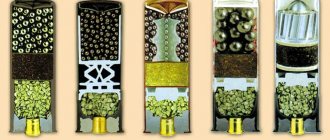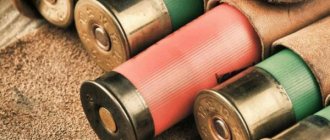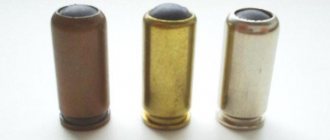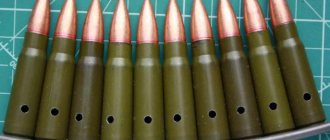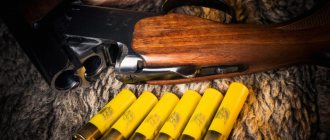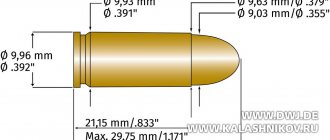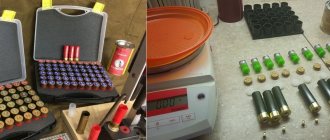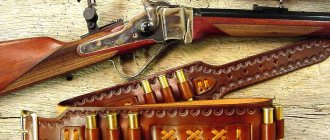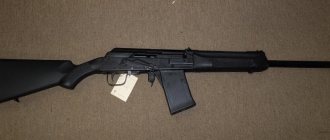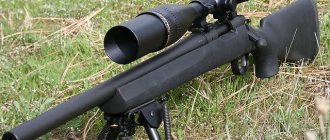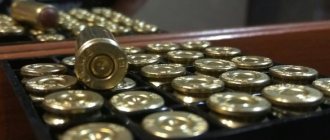- May 25, 2019
- Weapons and ammunition
- Anatoly Chugaev
Choosing a cartridge for a hunter can be compared to choosing fuel for a racing car - not a single athlete would risk filling with fuel of a brand and product characteristics unknown to him.
When choosing a cartridge, novice hunters are often guided by the price and appearance of the product. Many of them do not even know what length of cartridge case is acceptable for their gun.
You can understand all these subtleties without wasting a lot of time, you just need to pay attention to the following questions:
- What caliber is the gun?
- What is the sleeve length?
- Type of charge (shot, buckshot, bullet).
- What animal or bird are you planning to hunt?
- Seasonality of hunting (shot number depends on the season).
- Planned firing distance.
Caliber and chamber length
The calibers of hunting smoothbore shotguns are divided into three groups: large-caliber, medium-caliber, small-caliber.
- Large-caliber - 12, 10, 8, 4.
- Medium caliber - 16, 20, 24.
- Small-caliber - 28, 32.40.
Information about the caliber of the gun and the length of the chamber is in the passport of the weapon. For example, 12/76 - 12 gauge with a chamber for 76 mm cartridges. The chamber length is designed to use a 76 mm sleeve. The length of the loaded cartridge will differ to a smaller extent, depending on the weight and type of charge. The length is 76 mm - this is the size of the spent cartridge case. With a chamber length of 76 mm, it is allowed to fire cartridges of shorter length - 70; 65 mm.
Use of ammunition
It is very important to note here that recently hunting ammunition for this type of weapon has almost never been used. The situation is also the same with the use of caliber 8 and 4. The 10th caliber is quite actively used, but only in America. It can be added that the 410 group of cartridges has rather unique properties, and therefore it is rarely included in the general list of ammunition for such weapons. The bullet design for smoothbore products is as follows:
- The material for the sleeve can be cardboard, metal, plastic, and the diameter can also change;
- Next comes the igniter primer;
- after this comes the projectile itself - shot, bullet or buckshot;
- wads that differ in diameter;
- the last element is a charge of gunpowder, which can be either smoky or smokeless.
Type of planned hunt
Which projectile is suitable for the planned hunt can be found in the literature or checked with experienced hunters. When choosing a projectile, you need to take into account the type of muzzle narrowing of the gun. To hunt geese in flight, you need to use a choke, since shooting is carried out at extreme distances. When choosing a shot, it is advisable to choose numbers from No. 0000 to No. 3. A charge equipped with a container will be more effective than without it. It is possible to use small buckshot. Duck cartridges at this time of year can be equipped with shot No. 4 and No. 5. There are cases when experienced hunters switched to one shot number, using it for all types of hunting. For example, No. 3.
Mark Fetter
The Fetter cartridge company was founded in 2001. She became the heir to the Moscow Cartridge Plant, which was founded by N. N. Fetter in 1894. Today production is organized in the city of Klimovsk, which is located in the Moscow region.
The cartridges are manufactured using an Italian line from their own components. The gunpowder used is imported or Russian. Judging by the reviews of rangers, among Russian ammunition Fetter competes with the Glavpatron brand. The company produces all types of No. 12 caliber cartridges for different shooting distances and targets. These are special, Magnum, bullet, classic and sporting cartridges. They have their own names, for example, “Duck”, “Pheasant” and others.
The influence of time of year on the choice of cartridge
Hunting seasonality is an important factor when choosing a cartridge. When hunting grouse from the approach in early autumn, when the broods have just taken wing and take off 10-15 meters from the hunter, small shot and a muzzle attachment - a cylinder or a cylinder with pressure - are suitable. When hunting for black grouse at the end of December, when the bird is in dense winter plumage, preference is given to larger diameters - No. 3 and choke tubes - choke, poluchok. A stronger narrowing of the nozzles will increase the accuracy of the shot; this is important, since on winter days at subzero temperatures the accuracy of the shot decreases. Duck ammo will also vary depending on the hunting season. The favorable temperature for shooting at which all parameters are measured is 12°.
Glavpatron
“Cartridge Manufactory” began its activities in 2003, created on the basis of the Tula Cartridge Plant together with the Italian manufacturer of sports and hunting cartridges “Baschieri & Pellagri”. Today, cartridges are manufactured in the cities of Tula, Zarinsk, Timashevsk. Over the entire period, the plant has proven itself to be a reliable manufacturer. Among Russian factories, it shares first and second places in various ratings.
Today, this company produces the entire range of ammunition. There are cartridges for hunting different animals, for different shooting distances. The cartridges and gunpowder used are Italian. In addition, many components also come from Italy. Or these components are produced on German and Italian equipment.
According to hunters and athletes, Glavpatron is practically not inferior in quality and characteristics to the global manufacturers discussed above. Moreover, the cost of such ammunition is noticeably lower than imported ones.
Rating of 12 gauge hunting cartridges
To compare different brands of cartridges, the basic requirements will be taken: availability, quality, range.
While at the store counter, the hunter once again asks himself the question: which 12-gauge cartridges are better? The seller is always trying to make money and sell a product that is more expensive. If the cartridges are identical in characteristics, but the price differs, this can only be a consequence of the popularity of the brand.
12 gauge shotshells - which ones are better?
High-speed charges, charges with strong scree and destructive effect at short distances, sports charges with low weight and high density - this entire line is presented in Italian-made cartridges. Clover cartridges are an Italian brand that has been one of the leaders in the production of cartridges for many decades. Products of this brand have gained great popularity among athletes around the world. The price of a cartridge on domestic shelves ranges from 37 to 80 rubles per piece, depending on the equipment. Cartridges of this brand can be both high-speed for long distances and for short distances using irregularly shaped oval-shaped shot. Such shot gives a large scree and good speed at a short distance, about 20 meters. Even at long distances such charges are ineffective due to energy loss.
Fetter cartridges are a Russian brand, production was founded at the beginning of the 19th century. They have been on the market for quite a long time and have established themselves as a high-quality and at the same time budget product. The price of Fetter cartridges can start from 14 rubles. They are available in various calibers. They have a large product line, differing in the type of charge equipment. Due to their low price, they have become interesting for lovers of duck hunting on flights, when a large number of cartridges are fired.
Glavpatron 12-gauge cartridges are produced by the Tula plant. The quality of the cartridges is at a high level. Shot cartridges are loaded with hard shot, which increases the charge speed and gives a positive pellet. The price of the cartridge is from 21 rubles per piece. Glavpatron cartridges are available to most hunters and today, according to gun store sellers, are a bestseller.
If you are going to the opening of the hunting season, what numbers of 12 gauge cartridges will not be superfluous in your backpack? This is precisely the question that begins to interest the young hunter.
Let's say a company is going on a waterfowl hunt. What you need to consider when choosing cartridges: terrain, range and density, the presence of dogs trained to search for downed game. It is important to know the exact number of days planned for hunting in order to calculate the required number of cartridges. There are times when hunters return home early due to lack of ammunition. Based on the practice of experienced hunters, we can say that at the opening of the autumn duck hunt you will not need a large number of cartridges. In the first days the duck is very frightened and does not willingly fly. As a rule, the main flight of the bird occurs in the morning, at dawn, and lasts 30-40 minutes. One hunter needs 20-30 rounds of ammunition, loaded with shot No. 5 or No. 6.
But already at the beginning of October, when going hunting with stuffed animals on flights, you need to stock up on cartridges at the rate of an average of 50 pieces per day. This does not mean that the hunter will kill 50 birds. Anyone who has been on autumn flights during the days of mass duck migration knows that ducks fly from different directions and at extreme distances. You have to shoot a lot, but not all shots are effective. Days when strong winds blow are especially successful. A duck from deep water goes into the reeds and there, in hiding, it is met by hunters with decoys placed in small puddles. Such a hunt lasts all day, and not just on morning and evening flights. This is how she captivates the lion's share of hunters.
For an equally exciting hare hunt with hounds in winter, shot No. 2 and No. 3 are sufficient. But when hunting wood grouse, you need to take the cartridge charge more seriously. The capercaillie is a very strong bird; high-speed projectiles are well suited for successful shots. In them, the speed of the shot when meeting the target is high. The shot is sharp and destructive.
Beginner hunters do not have the task of understanding which 12 gauge cartridges are better. The question is which cartridges are for which hunting. One might say that there is no need to prevent a young hunter from achieving everything on his own. However, hunting is not a walk in the park; it is important to understand and follow safety precautions and, when shooting at an animal, remember that it is a living creature. The correct shot will be when the animal dies in motion, instantly.
A painful choice.
It has long been noticed that most of our hunters, in some important aspects of hunting life, continue to be staunch conservatives and deep retrogrades in the good sense of these words. This directly applies to our habits or preferences to hunt large ungulates and bears with smooth-bore guns and bullet cartridges for them.
It would seem that we lost the Eastern (Crimean) War 260 years ago to the British, the French, all sorts of Sardinians and Turks, partly because of the imperfect combat with bullets of the then army smooth-bore rifles, and we caused thousands of misses, and even wounded wounds during hunting, and that the bullet Mayer and similar “turbines” do not rotate in flight and are not stabilized according to the gyroscopic principle - they have proven, and for 30 years now we have the right to hunt with carbines and even target rifles that hit a squirrel in the eye at 300 m. But no, the same collective driven hunt for elk is more tempting to go with a familiar smooth-bore gun, shot and tested over the years. It turns out that everything is according to Turgenev - about our special love for hunting, even with a gun tied with ropes and a “lot” hammered into the barrel - but for a bear. So it is today - in my large hunting team consisting mainly of urban hunters, every time half or even more apply for a driven hunt for wild boar or elk with smoothbore guns.
Frank conversation at the store counter
A striking example of the special love and preference for smoothbore guns in game hunting is the famous shooting sports specialist and active, experienced hunter Sergei Spivak. Even now, like a quarter of a century ago, with all the opportunities to own any exquisite foreign carbine or rifle, he continues to go on his chosen driven hunts only with a smoothbore gun and has consistent success. Although he is no longer a young hunter, the animal often comes to his number and is always killed with one or two accurate shots. I have already given the example of another famous hunter of our North-Western region, Pavel Ivanov. During his long hunting practice, he obtained many trophies, including several hundred moose - all from his “golden”, as he said, Izh-54 smoothbore gun. Many other fellow hunters, both from the past, Soviet times, and modern ones, who prefer a smooth-bore rifle to a carbine when hunting in the taiga, are also remembered. And there will always be explanations for this, which we will return to in future articles on this topic.
From left to right: Poleva 6U, 33 g, Poleva 6, 33 g, Poleva 6, 40 g
Looking at the older generation of hunters, in some ways their mentors, our hunting youth also strive for successful hunting, which, alas, does not always work out. Although in the field of bullet shooting from a gun, we have had significant changes for the better over the past 15–20 years. For comparison, let's take a brief excursion into the not so distant past. By the third quarter of the last century, we had only a few types of bullets recommended by factories for wild game hunting and even fewer loaded factory cartridges, to put it mildly - not the best combat. For example, the technical conditions TU 84-596-75 “Hunting bullet cartridges 12-16-20 calibers” determined that the diameter of holes from ten bullets on a target at a firing distance of 45 m should not exceed: for Brenneke turbo rifle bullets - 60 cm; Mayer turbine type - 50 cm; switches VVOO-I - 50 cm; round “Sputnik” - 80 cm in 12 gauge, 70 cm in 16-20 gauge. This meant that the deviation of bullets from the aiming point at a distance of 45 m in any direction by 30–40 cm was acceptable and considered the norm (!).
What size must be the affected area on an animal carcass in order to obtain a trophy during a hunt with such a bullet cartridge? And at the same time, quite reasonable and even strict characteristics for combat accuracy, for example, were determined by the state standard GOST 18406–79 “Double-barreled smooth-bore hunting shotguns. General requirements". They established that the deviations of the centers of shot scree from the aiming point when shooting at a distance of 35 m were no more than: 15 cm up, 5 cm down and 7.5 cm left and right. Naturally, these guns had to hit with bullets with the same accuracy. In practice, shooter errors, unstable weapon positions during hunting shooting, and shooting at distances of 50 m or more caused even greater deflections of bullets. But not 70–80 cm, as stated above in the technical conditions.
From left to right: Poleva 2, 28 g, Poleva 3, 28 g, Poleva, 30 g
Although, indeed, the “vaunted” Mayer bullet of that time showed a bad fight, Rubeykin and “Kirovchanka” bullets often flew flat to the target, from the initial overloads of 45,000 g when fired, the “BS” and “Vyatka” bullets turned into simple bullets while still in the barrel “lot” - a piece of lead, VVOO-II “Ideal” hit a little better and the bullets of Brenneke, Jakan and Blondeau were made quite well without defects. And only the first bullet of the engineer of the Kirov Plant of Hunting and Fishing Equipment V.V. Polev, announced and released initially under the name “Victoria”, already in the early and first half of the 80s of the last century, during control shooting at a distance of 50 m, often gave accurate combat 7–12 cm in diameter. Today, as is known, Polev’s bullets, both lead and steel, of various types, “fly” with the same and even less dispersion already at a distance of 100 m (articles “Superspeed” and “Speediness” in “KALASHNIKOV” No. 4 and No. 8/2014).
It should be noted that experienced shooters and hunters, advanced in technology, also created dozens and hundreds of samples and designs of bullets, from the “lot” of the times of S. T. Aksakov and I. S. Turgenev, the pre-revolutionary bullets of A. A. Shirinsky-Shikhmatov, Witsleben and Yakana (popularly called “zhakan”) and so on. In addition, in the kitchens or garages of hunters, homemade bullet guns were heated, lead and impurities were melted, and bullets were cast—sometimes quite successful. Many of my trophies back then were also taken with a homemade cap-type bullet, like the American Foster bullet. It was a bullet from my friend, hunter Gennady Guryanov, who later gave me the “kitchen” technology for its manufacture. My colleague and co-worker Vitaly Serebryakov, a famous pistol shooter and a very passionate hunter, especially of bears on oats from the approach, at the end of the 70s of the last century created a successful arrow-shaped sub-caliber bullet, reminiscent of the French Sovestra bullet. At the very beginning of the 90s, together with engineers, I created and developed a bullet for my Browning BPS shotgun for the standard Browning “paradox” attachment. It weighed 47.5 g in caliber 12/76 and was very accurate at all real shooting distances for hunting “smoothbore” shooting, up to 120 m.
From left to right: Brenneke Opal Magnum, 43.5 g, Brenneke, 34 g, Gualandi, 40 g, Star Slug, 28.4 g, Brenneke, 39 g, Zala, 28 g, Grizzly (Paradox), 35 g, “Grizzly” (“paradox”), 40 g Zala, 32 g
In the new Russia, from the very beginning of the 2000s, the situation in this matter gradually began to change for the better, the market is being enriched with many types and brands of bullet cartridges, both domestic and foreign. It cannot be said that today all of our gun stores are trying to stock a rich assortment of bullet cartridges for smooth-bore guns, but there are exceptions, such as the St. Petersburg arms store “Bars”.
The other day, when I looked into Bars for a can of Sokol gunpowder, I noticed the range of cartridges and was pleasantly surprised - I counted about 40 variants of bullet cartridges of all major calibers, from 12 to .410. And now what should a young hunter (and not a young one too) do with the choice of a cartridge suitable for his gun? After all, the first test shooting from a new gun is always a test of the bullet’s combat. Properly carried out, it will clearly demonstrate both the advantages and the existing errors and disadvantages of the weapons complex. There is simply no other way to check, for example, the correct drilling of the bores of the barrels or their alignment at certain angles - the “triangles” and “rings” in the bores of the barrels “looked out” in the gun store are little joy, you need to be a specialist to figure it out. But there is another side to the matter - sometimes barrels during inspection show some obvious flaws in drilling, but when shooting they give an accurate and accurate fire. Despite all the seeming paradox of the situation, even today the smooth barrel of a gun remains fraught with more different “secrets” than a rifled one. Another thing is how carefully we study it and test it in practice. How many masters of the sport of clay pigeon shooting do we know who have never fired a bullet or even shot at a paper analytical target... We must keep in mind that inaccurate combat with significant deviations of the average point of impact from the aiming point when shooting bullets will certainly spoil shooting with shot, only in a more hidden, unclear form.
And, of course, an inexperienced hunter, faced with such a rich assortment of cartridges, willy-nilly will get lost and experience the agony of choice - what to choose? There is only one way - testing by shooting several of the most famous and proven bullets and cartridges. And the best place to start is with light to medium weight arrow-type sabot bullets. First of all, these are Polev bullets, not the most expensive and one of the highest quality in combat. Actually, for hunting large animals, I prefer heavy magnum bullets; as for training, control, recreational shooting, as well as hunting for various gilts, a high-velocity sub-caliber bullet always helps out.
From left to right: Grizzly (paradox), 40 g, Brenneke, 34 g, Gualandi, 40 g, Star Slug, 28.4 g, Brenneke, 39 g
Let's discuss the range of cartridges, in this case the Bars magazine, and highlight their main characteristics. First of all, it attracts two model ranges of bullet cartridges from our two cartridges and the Kirov KZORS. Of the ten presented brands of Techkreem cartridges, we will immediately highlight cartridges of caliber 12/89 and 12/76 as “supermagnum” and “magnum”. The first of them is used exclusively in shotguns with a chamber length of 89 mm, the second - with a chamber length of 76 mm. This is a strict rule related to the safety of shooting and operation of a gun. Cartridge 12/89, “supermagnum”, equipped with a Brenneke Opal Magnum bullet weighing 43.5 g, a charge of Sunar-42 gunpowder - 2.45 g. The initial bullet speed declared by the manufacturer is 460 m/s, the calculated kinetic energy is 4602 J. This the most powerful cartridge from this arsenal and, presumably, with considerable recoil when fired. Although the bullet mass is far from the maximum for this caliber, the “slow” Sunar-42 gunpowder correctly utilizes its energy and is gentle on the shooter’s shoulder. The declared accuracy of combat when firing from a factory ballistic barrel with a cylindrical drill at a distance of 50 m in a series of five shots is also striking - only 45 mm in diameter! Moreover, the cartridge is suitable for a barrel with any choke. Of course, this cartridge is a worthy gift for Izhevsk residents who own 12/89 caliber shotguns.
From left to right: B&P, 28 g Gualbo, 29 g, Gualandi, 32 g, Bison-S, 42 g
But there are much more of us hunters with 12/76 caliber shotguns, just “magnum”, and I, knowing the excellent performance of my Breda Echo self-loading shotgun with Original Brenneke and Gualandi bullets, have already ordered these cartridges for future hunts. These bullets are distinguished by high accuracy of combat at long distances of smooth-bore hunting shooting up to 100 m, and their weight of 39 and 40 g, combined with initial velocities of 420 m/s and 400 m/s, indicate remarkable destructive power with an estimated kinetic energy of 3440 J and 3200 J respectively. The hunter is also attracted by the note on the pack of cartridges “recommended up to 100 m.” The bullet is suitable for use in a barrel with any standard choke in 12 gauge.
Further, in the Tekhkrim products we see two “paradoxical” bullets, designed for firing from barrels equipped with “paradox”-type rifled sections or with a replaceable “paradox” muzzle attachment. These are “Grizzly 35” and “Grizzly 40” cartridges (by bullet weight). A hunter who has a gun with a “paradox” should definitely try this cartridge - in case it produces excellent or simply excellent accuracy. But this may not happen: “paradox” is not a simple thing, it can have various characteristics, such as the length of the rifled part, the diameter of the channel, the depth and pitch of the rifling and others, more or less suitable for a particular bullet. But a well-functioning barrel with a “paradox” attachment is a very formidable and at the same time very pleasant thing. A gun like this begs for an additional scope.
The five remaining Techkreem cartridges of 12/70 caliber can be used both in standard drill barrels (which are becoming increasingly rare in modern guns) with a chamber length of 70 mm, and in magnum barrels of 76 mm. These are Zala 28, Zala 32, Or. Brenneke 28 and 34, as well as a cartridge with a 28.4 g Star Slug bullet. Of these, special mention can be made of the Zala 32 cartridge for hunting and sport shooting from barrels with different choke constrictions (up to 1.25 mm), with a non-lead bore bullet , with an initial speed of 463 m/s (!). The calculated initial kinetic energy of the bullet is 3429 J. In factory tests (ballistic barrel of a cylindrical drill), the cartridge in a series of five shots showed an accuracy of 37 mm (at a distance of 50 m). And you need to put exclamation marks everywhere. Our generation of hunters did not have such cartridges in their youth. By the way, 37 mm accuracy is not the limit for the Techkreem cartridges; the above-mentioned Grizzly 35 cartridge, during factory testing, showed 32 mm in a series of five shots.
From left to right: “Strela”, 33 g, Royal MG, 32 g, Match “Bullet”, 28 g
In the group of KZORS cartridges, the magnum cartridge in caliber 12/76 with the Poleva-6 bullet weighing 40 g, the Sunar gunpowder 2.3 g, stands out. The note on the pack of cartridges is also impressive: “I guarantee quality.” V.V. Polev." There are cartridges with bullets "Poleva 6U" (33 g), "Poleva-6" (40 g), "Poleva-2" (28 g), "Poleva-3" (28 g) and "Poleva" (30 g) ). The manufacturer recommends using cartridges in barrels with a muzzle narrowing of no more than 1 mm. All these cartridges deserve the attention of the hunter for use both for control and training shooting, and, naturally, for various game hunts. My choice is a magnum cartridge with a Poleva-6 bullet weighing 40 g, which is almost unsurpassed in the accuracy of my gun. From Glavpatron I found three types of cartridges here: with the B&P (Baschieri & Pellagri) 28 g bullet, the Gualbo 29 g and the Gualandi 32 g. I only tested the cartridge with the Gualandi bullet - good accuracy. The “Record” turned out to be represented by two types of bullet cartridges - with the “Bison-S” bullet (42 g), as well as the “Strela” (33 g). In terms of presentation of the main characteristics of the cartridge on the pack, “Nitrogen” surpassed everyone - why should a hunter bother with knowing the weight of the bullet, its speed or some other “little things”? Therefore, it is not interesting to either consider them or present our reader with a very intriguing Pro. Hunter, nor the unusual NRG Match with the Match Bullet “for practical shooting and sporting” (???). And I was only pleased with the Rio cartridge with the Royal MG (Bala Slug) bullet, weighing 32 g in 12/70 caliber, with an initial speed of 460 m/s and an estimated kinetic energy of 3385 J. The cartridge is recommended by the manufacturer for long-range shooting. Tested at our editorial shooting ranges at 50 and 100 m with an “excellent” rating. Well, is the range impressive? Then choose at least 2-3 bullet cartridges that you like (at least 10 pieces of each), prepare the weapon for shooting and go to the shooting range or shooting range. We will tell you what and how to do with a gun and cartridges in the next issues of KALASHNIKOV.
How did the division of smoothbore guns into calibers come about?
The division of hunting smoothbore shotguns into calibers came from England. Without going into specific calculations and speaking in simple language, it should be said that a certain number of bullets were cast from one pound of lead. Their number is an indicator of caliber. For example, 12 bullets from one pound of lead. The diameter of each such bullet corresponds to the diameter of the barrel drill. The most popular is 12 gauge. For connoisseurs of semi-automatic smooth-bore weapons, you have to understand in more detail which 12-gauge cartridges are best suited for self-loading shotguns. There are semi-automatic machines that do not depend on the characteristics of the cartridge and can easily reload all cartridges suitable for their caliber. Such semi-automatic machines include the legend - “Beretta A-390”. For its ability to work flawlessly with all cartridges, it was called “omnivorous.”
In order to understand which 12-gauge cartridges are best suited for a double-barreled shotgun, there is no need to rack your brains. It is enough to know the size of the chamber, the caliber and the size of the choke.
What do they say about Vetter Half-Magnum?
The characteristics of the Vetter Semi-Magnum cartridges impress many. The initial flight speed is at around 320 meters per second. In this case, plastic sleeves are used. They contain sediment, so they have good stabilization. In total, the pack contains 25 rounds. All of them are equipped with Chedit type capsules. Additionally, it should be noted that gunpowder is used with the “Falcon” marking.
“Polu-Magnum” is well suited for hunting and gets damp extremely rarely, which makes buyers very happy. These 16-gauge Fetter cartridges tolerate sub-zero temperatures well. However, it is important for the hunter to keep them clean. When dirt gets into the container part, the cartridges begin to become damp. Stabilization is achieved through the use of fairly heavy bases. The Fetter semi-magnum wad cartridges have a special gasket.
Differences between 12 and 16 gauge
Delving deeper into the qualitative difference between the two parameters - 12 and 16, it is worth considering the advantages of one and the other. The advantages of the 12 gauge are that the charge is much stronger than the 16 gauge and has a larger amount of shot, which means it has a greater damaging effect. When talking about a bullet charge of this magnitude, it is worth focusing on the greater stopping power due to the greater weight of the bullet. The advantages of the 16-gauge: the price of cartridges is lower, the weight of the gun and bandoleer is less than that of the 12-gauge. A smaller diameter bullet hits more accurately.
Magnum cartridges
Currently, Magnum hunting cartridges are actively used by many hunters. A distinctive feature of the Magnum is that the power, that is, the energy of the bullet’s ejection, is significantly higher than that of projectiles of a similar caliber and diameter. Thanks to the enhanced composition and increased power with a similar diameter, such ammunition has increased destructive power, which makes it possible to hunt large animals. There are also a number of models of special hunting weapons, the muzzle energy of which is optimal for such projectiles, and the barrels are more durable to withstand high loads when shooting.
Magnum bullet cartridges also have external differences in size. The main thing is that their sleeves are longer. The most common are 89 mm and 76 mm sleeves. Cartridges with a case length of 89 mm were first introduced into circulation by the American manufacturer in 1987. But ammunition with a case length of 76 mm began to be actively used even earlier than 89 mm - after the end of World War II.
Today, Magnum cartridges are produced in diameters of 10, 12, and 20 calibers, which are most common in America, and accordingly, the maximum length of such ammunition is 89 mm. In recent years, there has been a trend among many weapon manufacturers to switch to 89 mm ammunition length. First, Magnums with a length of 89 mm began to be mass-produced by the American company Mossberg. 89 mm cartridges were intended for single-barreled magazine weapons with a bolt action (otherwise called a longitudinally sliding rotary action). Following the Americans, many companies began to produce weapons with chambers designed for 89 mm cartridges instead of 76 mm.
In addition, Magnum hunting bullets of 410 caliber have recently appeared, which are distinguished by an even greater ability to damage a target due to the muzzle energy of the weapon and increased speed. Such bullets have smaller dimensions and are not produced in a length of 89 mm. The same goes for 20 gauge ammunition. Most manufacturers make 10 or 12 gauge Magnum ammunition for chamber lengths from 76 to 89 mm.
It should be noted that after active production of Magnum cartridges began, the number of calibers of smoothbore weapons was significantly reduced. Thus, manufacturers were able to provide customers with optimally sized ammunition with high power and low cost.
Today, not all hunters recognize the effectiveness of Magnum cartridges. On the one hand, both Magnum and standard cartridges for hunting weapons perform the same function, hitting the intended target. However, on the other hand, the feasibility of using Magnum cartridges has been proven in practice. The shot in such ammunition has more weight, therefore the entire shot projectile is increased. As a result, the density of pellet dispersion increases. If in order to defeat an animal it is necessary that at least 3 pellets hit it, then using Magnum this can be achieved at a greater distance than when using conventional fractional options.
For Magnum cartridges, both regular and special gunpowder can be used, which in turn allows you to influence the energy when ejecting shot, thus affecting the lethality.
In general, Magnum is a more powerful cartridge option that can be used both for hunting and for self-defense. Today, both domestic and foreign manufacturers produce Magnum cartridges.
Hunter Ethics
You can often see a young hunter buying a five-round shotgun, a huge bandolier, a knife that resembles a machete, and looking at him, you get the impression that a combat helicopter is about to arrive and he will urgently fly off to save the world. Years later, when meeting with the same person, you will notice that the heavy semi-automatic has already been replaced by a light double-barreled shotgun. A small backpack with 5-10 rounds of ammunition is slung over his shoulder. Communicating with nature, a person tries to be a part of it, and not a conqueror. It is no longer important to get game, but to be alone with nature. Experienced hunters do not get a charge of emotion from the amount of game they catch; it is enough for them to watch a cop working in the field or listen to the moaning voices of hounds who have seen a hare raised from the edge of the forest.
Consumer reviews of "Fetter Fox"
These Fetter cartridges receive a wide variety of reviews, and their characteristics are quite impressive. In this case, the initial speed of the bullet is at around 290 meters per second. The gunpowder they use is “Falcon” class. They are ideal for winter hunting. Additionally, it should be taken into account that these Fetter cartridges are classified as containerless. Due to this, they are not afraid of dirt, which cannot but please the shooter.
If you believe the reviews of the owners, then their returns are not significant. High stabilization of the cartridges was achieved through the installation of an aluminum base. In turn, the capsule is used with a ignition hole. According to the owners, misfires occur very rarely. In this case, the suspension is installed under the wad. The sleeve itself is of the brass type. Even after many years of storage, it does not lose its properties.
